Japanese trio need to 'let go'
![]() 06/09 2025
06/09 2025
![]() 448
448

Original content by New Energy View (ID: xinnengyuanqianzhan)
Full text: 3039 words, reading time: 12 minutes
'I lost 20,000 yuan before even picking up the car!'
This complaint from Mr. Li, a prospective owner of Dongfeng Nissan's N7, reveals the current awkward situation of Japanese cars.
This new model, which has only been on the market for a little over a month, suddenly offered discounts recently - those who place orders before June 30 can enjoy up to 19,888 yuan in purchase subsidies and up to 8,000 yuan in trade-in subsidies.
It is worth noting that such 'flash sales' are not unique among Japanese cars.
On April 15, Dongfeng Honda's S7 dropped by 60,000 yuan just one month after its launch, aligning with the guidance price of its sibling model, GAC Honda's P7, which was launched on the same day.
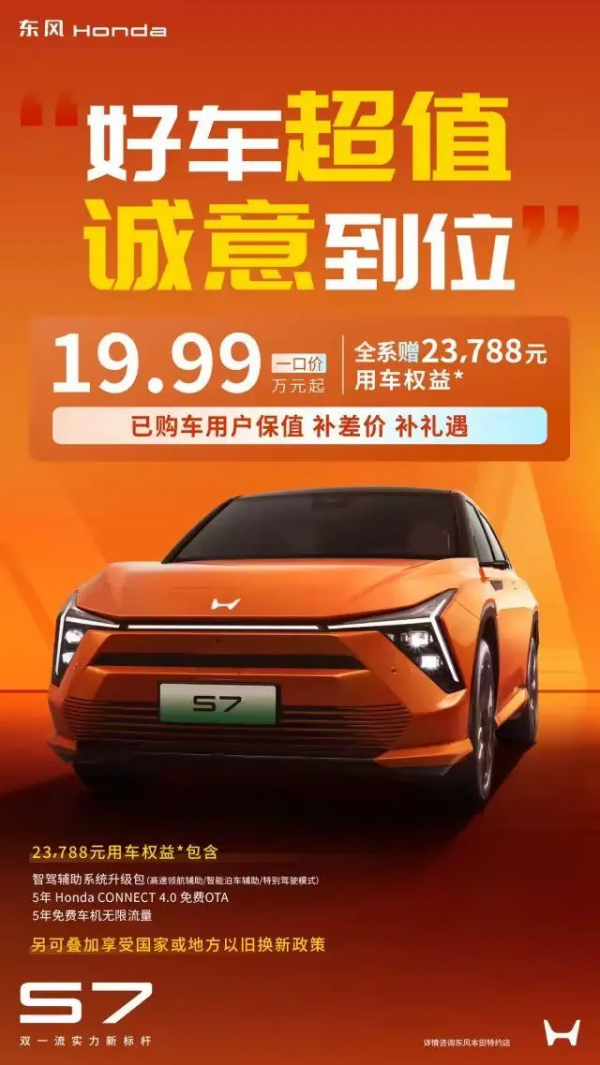
Image/Dongfeng Honda S7 starting price reduced to 199,900 yuan
Source/Internet screenshot from New Energy View
Back in 2020, Japanese cars occupied nearly a quarter of the Chinese automotive market due to their fuel economy, reliable quality, and comfortable ride experience. At that time, it was common for consumers to willingly pay extra and wait in line to pick up their cars.
For example, the Honda CR-V once required an additional 30,000 yuan on top of its price range of 170,000 to 270,000 yuan; the Toyota Highlander once required an additional 30,000 to 50,000 yuan or a wait of several months to pick up the car.
However, today, the former 'myths' have long been shattered, with the Honda CR-V falling below the 120,000 yuan mark, and the Toyota Highlander offering comprehensive discounts of 70,000 to 100,000 yuan in some regions.
This inevitably raises the question: in the fiercely competitive market, how long can the story of the Japanese trio continue?
1. Struggling year after year, but losing ground step by step?
2020 was like a watershed. As new energy vehicles gradually entered thousands of households, the days of Japanese cars 'making money while lying down' were gone forever. In the four years since then, the situation of Japanese cars in the Chinese market has deteriorated, and by 2024, their overall market share in China had fallen by more than ten percentage points compared to 2020.
To turn the tide, Nissan and Honda successively resorted to 'price cuts'. The once easily selling over 10,000 units per month, the Sylphy and Civic, can now only survive by frequently cutting prices. The starting price of the Sylphy has dropped to around 80,000 yuan, and the dealer terminal price of the Honda Civic has fallen by nearly 50,000 yuan.
However, 'trading volume for price' has not effectively curbed the decline of Nissan and Honda.
From January to April this year, Nissan Motor China, including its passenger vehicle and light commercial vehicle businesses, sold a cumulative total of 167,600 vehicles, a year-on-year decline of 24.6%; Honda sold a cumulative total of 202,000 vehicles in the Chinese market, a year-on-year decline of 28%.
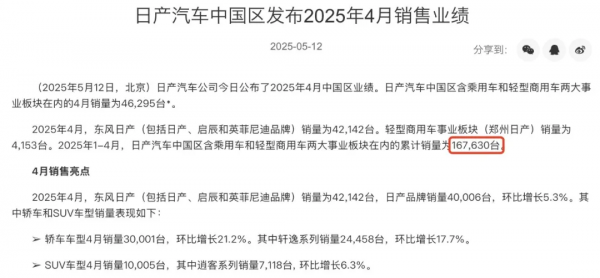
Image/Partial sales data for Nissan Motor in April
Source/Internet screenshot from New Energy View
The continuous loss of sales has forced Nissan and Honda to make more difficult structural adjustments.
On the Nissan side, in March, there was a major reshuffle of senior management within the company. Out of the five-person management team led by Makoto Uchida, the president and three vice presidents were dismissed, and Ivan Espinosa, the former chief planning officer, took over as president.
On May 13, Nissan Motor announced that, including the 9,000 job cuts announced in November last year, it expects to lay off 20,000 employees globally by fiscal year 2027, accounting for about 15% of the company's total workforce; at the same time, it will reduce the number of factories worldwide from 17 to 10 by fiscal year 2027.
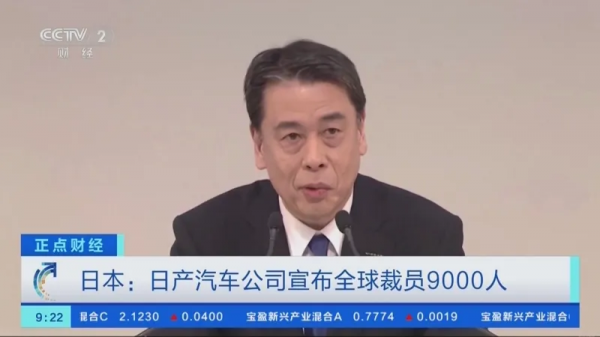
Image/Global layoffs at Nissan Motor
Source/Internet screenshot from New Energy View
In the same month, there were even rumors that Nissan might sell its headquarters building to raise funds. As of press time, Nissan has not made a public response to this, but its dire situation is self-evident.
On the Honda side, in May, GAC Honda also initiated a large-scale layoff, involving multiple departments and expected to affect thousands of people.
In contrast, Toyota is currently in a relatively good position among the Japanese trio, with cumulative sales of 530,100 vehicles from January to April this year, a year-on-year increase of 7.7%. However, upon deeper analysis, its current performance seems to be a 'pseudo-prosperity' that is difficult to sustain - the apparent stability of sales in China is based on price cuts across its main models.

Image/Cumulative sales of Toyota Motor from January to April 2025
Source/Internet screenshot from New Energy View
For example, the Camry, which had a cumulative retail sales volume of 58,800 units from January to April, currently offers discounts of over 30,000 yuan on average; the Corolla, with a cumulative retail sales volume of 31,300 units, offers comprehensive discounts of 43,000 yuan, with a starting price of 79,800 yuan.
'When buying a car now, I pay more attention to technological configuration and intelligent experience. Japanese cars feel relatively backward in this regard and do not meet the aesthetic and needs of young people like us.'
'Japanese cars give people a conservative impression, lacking innovation and a sense of technology.' Multiple consumers admitted.
Most former loyal users of Japanese cars said that they originally preferred Japanese cars for their fuel efficiency and reliability, but now the rapid development of new energy vehicles has made 'electricity cheaper than oil', eroding Japanese cars' original advantages. 'The interior configuration of Japanese cars is outdated, and the gap with autonomous brands' refrigerators, TVs, and large sofas is obvious, making people have to switch to other brands.'
2. From easy questions to fatal ones, why have Japanese cars become 'no-name brands'?
It is worth noting that facing the path of electric transformation, Japanese cars had the opportunity to seize the opportunity and easily occupy a place in the new energy market with their historical accumulation. However, the reality is that they did not seize the opportunity and gradually became marginal players in the new energy market, and even equated with 'no-name brands' in the minds of some consumers.
Take the new Japanese new energy vehicles launched in the past two months as an example: Dongfeng Nissan's N7, with an official guide price of 119,900 to 149,900 yuan, sold 665 units in April; Dongfeng Honda's S7, with a starting price of 259,900 yuan on the day of its launch, is now priced at 199,900 to 249,900 yuan, and sold 373 units in its first month; GAC Honda's P7, with an official price of 199,900 to 249,900 yuan, sold 437 units in its first month.
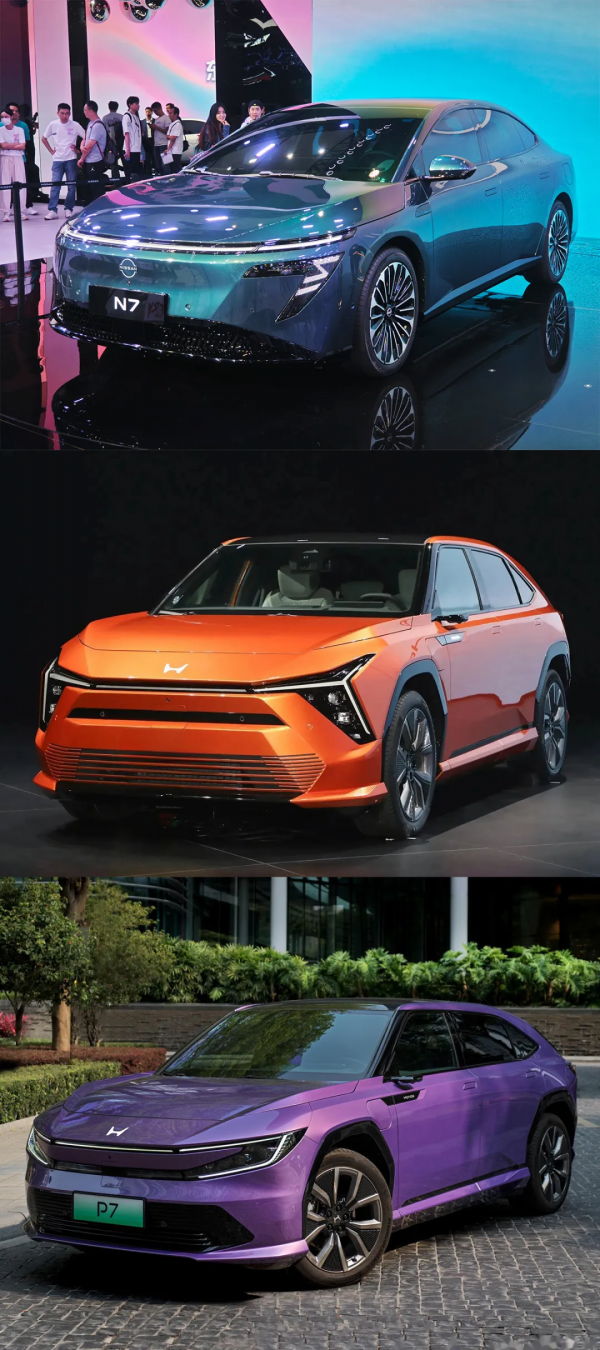
Image/Dongfeng Nissan N7 - Dongfeng Honda S7 - GAC Honda P7
Source/Internet screenshot from New Energy View
Behind the ' Mute Fire ' (lackluster performance) of these three new models is not only the announcement that they failed to achieve a 'successful launch' but also the exposure that it is difficult to replicate the myth of Japanese fuel vehicles being 'instant hits' upon launch, even if there is room for growth in subsequent sales.
The Guangqi Toyota BZ3X, priced at 104,800 to 154,800 yuan, has a more optimistic market response compared to the other three Japanese new energy vehicles, but its cumulative delivery of 15,000 units in 85 days since its launch still pales in comparison to models with monthly sales consistently exceeding 10,000 units, such as XPeng's MONA M03 and Xiaomi's SU7.
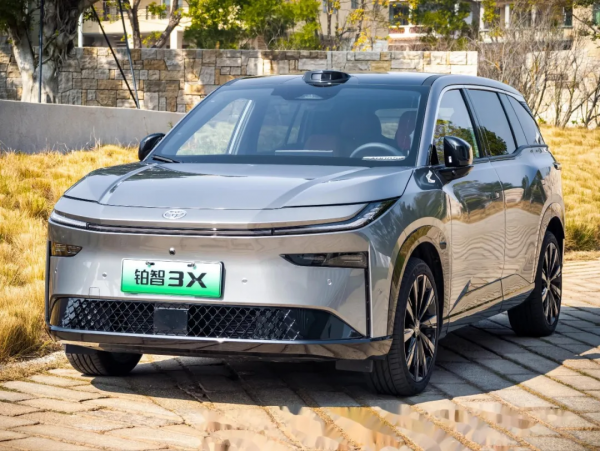
Image/Guangqi Toyota BZ3X
Source/Official Weibo of Spicy Car Reviews screenshot from New Energy View
A good hand was played badly. What went wrong?
The root cause may be related to strategic misjudgments and entering the electric vehicle market too late. In 2020, when autonomous brands were focusing on electric transformation and launching multiple models, Japanese cars were still taking a wait-and-see attitude towards the development of electrification.
At that time, Akio Toyoda, the chairman of Toyota Motor, which advocates hydrogen energy, even publicly questioned the overhype of pure electric vehicles and asserted that they would kill enterprises, require huge investments, and emit more carbon dioxide.
At the same time, Japanese cars are trapped by their advantages in traditional automotive core technologies such as fuel engines and transmissions. Facing the wave of electrification, it is difficult for them to let go of the mature fuel vehicle industry chain and quickly establish new technical barriers.
Industry insiders believe that the crux of the transformation of Japanese brands stems more from themselves. Traditional automakers, especially these joint ventures as foreign brands, are now inherent stakeholders. 'Toyota is number one globally and makes so much profit every year. At this time, to change means changing Toyota's own advantages and giving up its own strengths, which is very difficult.'
The backwardness of product technology is also a major 'stumbling block' for Japanese cars in their electric transformation. Their once-prized fuel economy has lost competitiveness in the face of the reality that 'electricity is cheaper than oil'; interior design, intelligent configuration, etc., are even more out of place compared to the refrigerators, TVs, large sofas, and human-computer interaction of Chinese autonomous brands.
3. From price cuts to 'localization', can Japanese cars usher in a new life?
Facts have proved that relying solely on price cuts cannot fundamentally reverse the decline of Japanese cars.
In contact with many consumers, we gradually discovered that although the prices of Japanese cars have decreased, consumer enthusiasm for them has not significantly increased. 'The interior design and intelligence are far behind domestic cars. Unless the price is halved, it is difficult to convince me to pay for these 'last-generation' products, as sentiment cannot support the frustrating experience of daily use.'
As a result, Japanese cars have begun to seek deeper reforms - 'localization'.
In early February this year, Toyota China announced that it will establish a wholly-owned company in Shanghai for the research, development, and production of Lexus electric vehicles and batteries, with plans to start production in 2027 with an annual production capacity of 100,000 units and a localization rate of components exceeding 95%.
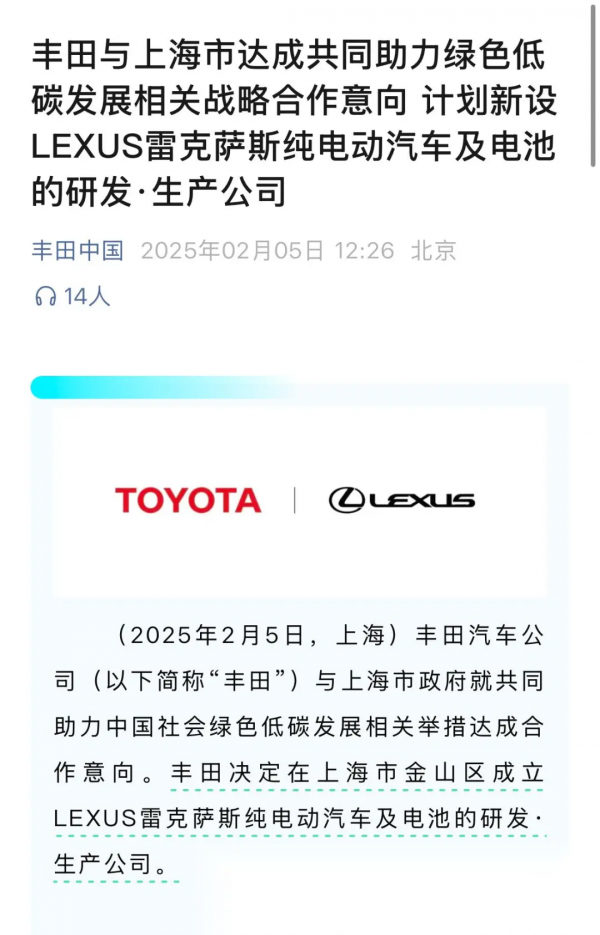
Image/Toyota and Lexus reach cooperation in Shanghai
Source/Internet screenshot from New Energy View
This is not only the first time that Lexus will achieve localized production in China but also means that Toyota is trying to deeply bind itself to China's supply chain and get closer to the Chinese market.
At the same time, Honda and Nissan have also deepened their cooperation with leading Chinese enterprises such as CATL and Huawei.
Specifically, Honda and CATL will further upgrade their cooperation in areas such as lithium iron phosphate batteries, CTB integration technology, supply chain optimization, and 12V and hybrid battery research and development based on their existing cooperation; its new electric brand 'Ye', specifically created for the Chinese market, even directly incorporates Huawei's intelligent driving system.
Dongfeng Nissan will not only apply CATL's cutting-edge technologies such as all-domain supercharging, CIIC integrated intelligent chassis, and 800V high-voltage platform but also jointly develop intelligent cockpits with Huawei and introduce Huawei's intelligent driving system and HarmonyOS cockpit technology.
These 'localization' moves seem to be paying off initially. Honda's concept car Ye GT and Toyota's BZ7 have gained initial recognition from consumers with configurations that are closer to local needs. At this year's Shanghai Auto Show, the Japanese auto exhibit booths changed from their previous desolation to a bustling scene with a steady stream of visitors.
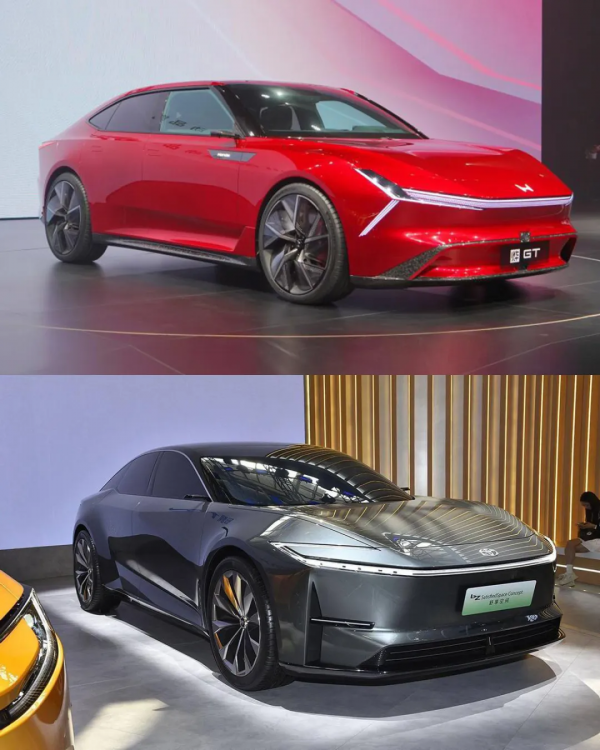
Image/Ye GT - Toyota BZ7
Source/Internet screenshot from New Energy View
However, beneath the lively appearance, crises still lurk. Compared to the implementation of 'localization', what Japanese cars need to fundamentally address is their wavering attitude towards electric transformation.
Take Honda as an example. Just four days after signing a memorandum of understanding with CATL to deepen cooperation, on May 20, it suddenly announced a significant reduction in electric vehicle investment, cutting last year's investment plan of 10 trillion yen to 7 trillion yen. This move sparked heated discussions in the consumer market.
Many loyal fans of Japanese cars are deeply disappointed and confused by this. They admitted that they have a hard-to-let-go sentiment towards Japanese cars, and this sentiment is the last driving force supporting their continued interest. However, sentiment cannot be a meal. If product strength cannot keep up with the times, losing fans is just a matter of time.
For Japanese cars, although they have 'seen the light' and focused on localization, there is still a lot of catching up to do. Consumers' patience is running out, and the window of opportunity left for them in the market is also constantly narrowing. At this critical juncture, the Japanese trio needs to 'let go'.








